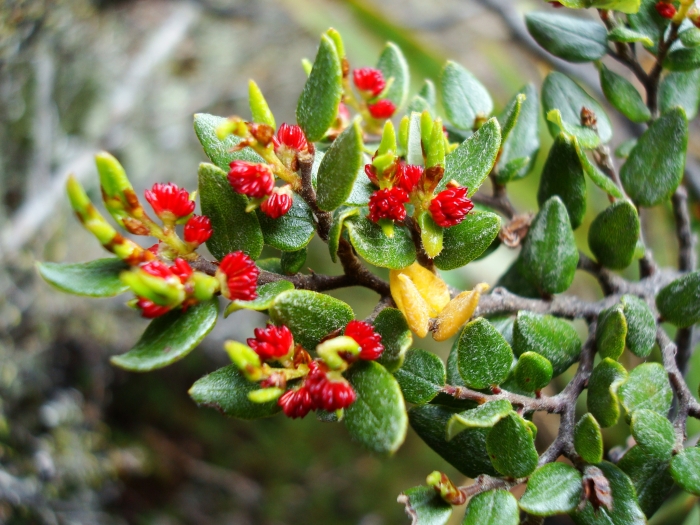Mountain Beech
(Nothofagus cliffortioides)
Mountain Beech (Nothofagus cliffortioides)
/
/

Sarah Richardson
CC BY 4.0
Image By:
Sarah Richardson
Recorded By:
Copyright:
CC BY 4.0
Copyright Notice:
Photo by: Sarah Richardson | License Type: CC BY 4.0 | License URL: http://creativecommons.org/licenses/by/4.0/ | Rights Holder: Sarah Richardson | Publisher: iNaturalist | Date Created: 2008-12-26T10:50:57-08:00 |

























Estimated Native Range
Summary
Nothofagus cliffortioides, commonly known as Mountain Beech, is a deciduous tree endemic to New Zealand. It thrives in subalpine and montane forests, particularly in the Southern Alps, where it is a key component of the ecosystem. Mountain Beech can reach up to 66 feet (20 meters) in height in lower elevation forests but adopts a stunted form, known as "goblin forest," at higher elevations near the treeline, where trees are typically no more than 6 feet 7 inches (2 meters) tall. The species exhibits a smooth, silver-grey bark and small, leathery leaves. It is not commonly known for showy flowers but produces small, inconspicuous ones.
Mountain Beech is valued for its ecological role, as it hosts a variety of lichens and fungi, and provides food for the mountain beech flat moth. It is not widely used in cultivation outside of New Zealand due to its specific habitat requirements. However, in its native region, it is appreciated for its hardiness and adaptability to cold environments. The tree prefers well-drained, acidic soils and can tolerate a range of light conditions from full sun to partial shade. While not typically grown for ornamental purposes, it can be used in reforestation projects and habitat restoration. Potential problems include susceptibility to certain diseases and pests, such as Phytophthora.CC BY-SA 4.0
Mountain Beech is valued for its ecological role, as it hosts a variety of lichens and fungi, and provides food for the mountain beech flat moth. It is not widely used in cultivation outside of New Zealand due to its specific habitat requirements. However, in its native region, it is appreciated for its hardiness and adaptability to cold environments. The tree prefers well-drained, acidic soils and can tolerate a range of light conditions from full sun to partial shade. While not typically grown for ornamental purposes, it can be used in reforestation projects and habitat restoration. Potential problems include susceptibility to certain diseases and pests, such as Phytophthora.CC BY-SA 4.0
Plant Description
- Plant Type: Tree
- Height: 15-80 feet
- Width: 20-40 feet
- Growth Rate: Moderate
- Flower Color: Green
- Flowering Season: Spring
- Leaf Retention: Deciduous
Growth Requirements
- Sun: Full Sun, Part Shade
- Water: Medium
- Drainage: Medium, Fast
Common Uses
Border Plant, Low Maintenance
Natural Habitat
subalpine and montane forests, particularly in the Southern Alps
Other Names
Common Names: Narrow-leaved Red Beech
Scientific Names: , Nothofagus cliffortioides, Cliffortoides oblongata, Fagus cliffortioides, Fuscospora cliffortioides,
GBIF Accepted Name: